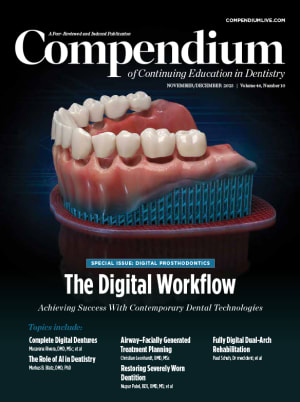Your Partner in Practice
AI can simply be viewed as an intelligent, hard-working partner that enhances your practice and enables you to provide better care to patients.
By now you may be tired of hearing about how artificial intelligence (AI) is going to revolutionize your practice. You already know that AI can help increase productivity, improve diagnosis and treatment planning, and streamline administrative tasks. Perhaps you've implemented some aspects of this "game-changing" technology, or not. Either way, you believe it is time to do more with AI, but you don't want it "taking over" your practice and making decisions for you.
Fortunately, as AI continues to permeate healthcare, dentists are learning that it isn't the threatening menace that some may have anticipated. Rather, AI can simply be viewed as an intelligent, hard-working partner that enhances your practice and enables you to provide better care to patients.
We examine AI's impact on dentistry in this issue of Compendium. Our first continuing education (CE) article discusses how AI, along with augmented reality (AR), is changing the realm of dental education. These technologies are facilitating more personalized, interactive learning experiences for dental students and allowing them to develop skills in risk-free environments where they can gain valuable feedback in real-time. The authors explore current applications of AI and AR in dental education and highlight key AI-driven advancements in dentistry. The article also identifies challenges to the widespread adoption of AI tools in dental education. What's clear is that AI and immersive technologies such as AR and virtual reality are reshaping how dental students acquire knowledge, develop technical skills, and transition into clinical practice.
In our other CE article we look at the critical nature of periodontal phenotype, and how thick versus thin phenotype impacts oral health outcomes. The article focuses on the classification of periodontal phenotype and reviews indications for phenotype modification. Other clinical reports in this issue cover the use of platform switch implants for cervical bone preservation, the "stamp" technique to achieve accurate occlusal topography for direct composite restorations, and a case of multiple lip mucoceles.
Finally, be sure to read The Voice article by Dr. Walther, who assures dentists that AI is not coming for your job, but rather, serves as a support system-a trustworthy ally, if you will-in your quest to be the best dentist you can be.
Sincerely,
Markus B. Blatz, DMD, PhD
Editor-in-Chief
markus.blatz@conexiant.com
